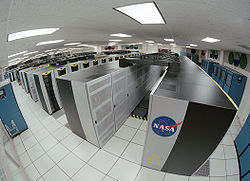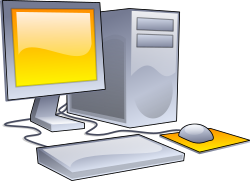Types of computers
 From Wikiversity - Reading time: 5 min
From Wikiversity - Reading time: 5 min
Main Course Launch Page - Data Size and Speeds
Exit Supplmental Material
Supplemental Course Navigation
| << Previous - Data Coding and Information Decoding | Next - What is a motherboard >> |
|---|
This is a lesson in the course Introduction to Computers, which is a part of The School of Computer Science
| Educational level: this is a secondary education resource. |
| Type classification: this is a lesson resource. |
| Completion status: this resource is ~75% complete. |
This is a resource to learn about different types of computers that exist.
Supercomputer
[edit | edit source]
Supercomputers are the fastest and the most expensive computers. These huge computers are used to solve very complex science and engineering problems. Supercomputers get their processing power by taking advantage of parallel processing; they use lots of CPUs at the same time on one problem. A typical supercomputer can do up to ten trillion individual calculations every second. Example Supercomputers:
Quantum computer
[edit | edit source]The industry is replacing Supercomputer with Quantum Computers

- Measures in “Qubits”
Mainframe
[edit | edit source]
Mainframe (colloquially, "big iron") computers are similar to supercomputers in many aspects, the main difference between them is the fact that a supercomputer uses all its raw power to focus on very few tasks, while a mainframe perform thousands or millions of operations concurrently. Due to its nature, mainframes are often employed by large organizations for bulk data processing, such as census, industry and consumer statistics, enterprise resource planning and transaction processing.
Server Computer
[edit | edit source]
A server is a central computer that contains collections of data and programs. Also called a network server, this system allows all connected users to share and store electronic data and applications. Two important types of servers are file servers and application servers.
Servers are a step below supercomputers because they don't focus on trying to solve one very complex problem but try to solve many similar smaller ones. An example of servers would be the computers that Wikipedia stores its encyclopedia on. Those computers have to go and find the page you're looking for and send it to you. In itself, it's not a big task, but it becomes a job for a server when the computers have to go and find lots of pages for a lot of people and send them to the right place. Some servers, like the ones Google uses for something like Google Documents, have applications on them instead of just files, like Wikipedia.
Workstation Computer
[edit | edit source]
Workstations are high-end, expensive computers that are made for more complex procedures and are intended for one user at a time. Some of the complex procedures consist of science, math and engineering calculations and are useful for computer design and manufacturing. Workstations are sometimes improperly named for marketing reasons. Real workstations are not usually sold in retail, but this is starting to change; Apple's Mac Pro would be considered a workstation.
The movie Toy Story was made on a set of Sun (Sparc) workstations [1]
Personal Computer or PC
[edit | edit source]
PC is an abbreviation for a Personal Computer, it is also known as a Microcomputer. Its physical characteristics and low cost are appealing and useful for its users. The capabilities of a personal computer have changed greatly since the introduction of electronic computers. By the early 1970s, people in academic or research institutions had the opportunity for single-person use of a computer system in interactive mode for extended durations, although these systems would still have been too expensive to be owned by a single individual. The introduction of the microprocessor, a single chip with all the circuitry that formerly occupied large cabinets, led to the proliferation of personal computers after about 1975. Early personal computers, generally called microcomputers, sold often in kit form and in limited volumes and were of interest mostly to hobbyists and technicians. By the late 1970s, mass-market pre-assembled computers allowed a wider range of people to use computers, focusing more on software applications and less on the development of the processor hardware. Throughout the 1970s and 1980s, home computers were developed for household use, offering some personal productivity, programming and games, while somewhat larger and more expensive systems (although still low-cost compared with minicomputers and mainframes) were aimed for office and small business use.
Today a personal computer is an all-around device that can be used as a productivity tool, a media server and a gaming machine. The modular construction of the personal computer allows components to be easily swapped out when broken or upgrading.
Microcontroller
[edit | edit source]
Microcontrollers are mini-computers that enable the user to store data and execute simple commands and tasks. Many such systems are known as embedded systems. The computer in your car, for example, is an embedded system. A common microcontroller that one might come across is called Arduino.
Smartphone
[edit | edit source]
A smartphone is a mobile device that combines cellular and mobile computing functions into one unit. They are distinguished from feature phones by their stronger hardware capabilities and extensive mobile operating systems, which facilitate wider software, internet (including web browsing[1] over mobile broadband), and multimedia functionality (including music, video, cameras, and gaming), alongside core phone functions such as voice calls and text messaging. Smartphones typically contain a number of metal–oxide–semiconductor (MOS) integrated circuit (IC) chips, include various sensors that can be leveraged by their software (such as a magnetometer, proximity sensors, barometer, gyroscope, or accelerometer), and support wireless communications protocols (such as Bluetooth, Wi-Fi, or satellite navigation).[1]
References
[edit | edit source]Supplemental Course Navigation
| << Previous - Data Coding and Information Decoding | Next - What is a motherboard >> |
|---|
 KSF
KSF